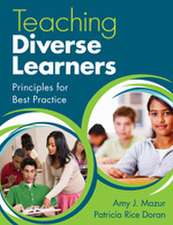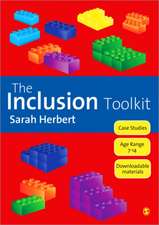Understanding Assessment in the Special Education Process: A Step-by-Step Guide for Educators
Editat de Roger Pierangelo, George A. Giulianien Limba Engleză Paperback – 14 ian 2008
| Toate formatele și edițiile | Preț | Express |
|---|---|---|
| Paperback (1) | 224.49 lei 43-57 zile | |
| SAGE Publications – 14 ian 2008 | 224.49 lei 43-57 zile | |
| Hardback (1) | 443.58 lei 43-57 zile | |
| SAGE Publications – 14 ian 2008 | 443.58 lei 43-57 zile |
Preț: 224.49 lei
Nou
Puncte Express: 337
Preț estimativ în valută:
42.96€ • 44.96$ • 35.75£
42.96€ • 44.96$ • 35.75£
Carte tipărită la comandă
Livrare economică 31 martie-14 aprilie
Preluare comenzi: 021 569.72.76
Specificații
ISBN-13: 9781412917919
ISBN-10: 1412917913
Pagini: 136
Dimensiuni: 178 x 254 x 8 mm
Greutate: 0.29 kg
Ediția:1
Editura: SAGE Publications
Colecția Corwin
Locul publicării:Thousand Oaks, United States
ISBN-10: 1412917913
Pagini: 136
Dimensiuni: 178 x 254 x 8 mm
Greutate: 0.29 kg
Ediția:1
Editura: SAGE Publications
Colecția Corwin
Locul publicării:Thousand Oaks, United States
Recenzii
"Short and to the point—a huge advantage! Easy to read and to understand. A must-have for every school building in every district."
"This book clearly does just what it promises, providing a step-by-step guide about the special education assessment process."
"From understanding basic statistics to understanding the foundations of the MDT, this is a powerful tool that educators need."
"This book clearly does just what it promises, providing a step-by-step guide about the special education assessment process."
"From understanding basic statistics to understanding the foundations of the MDT, this is a powerful tool that educators need."
Cuprins
About the Authors
Acknowledgments
Introduction
Step I. Understanding Assessment and Special Education Assessment
Importance of Assessment
Purpose of Assessment
The Difference Between Testing and Assessment
Role of the Education Professional in the Special Education Process
Assessment and Federal Law
Step II. Understanding and Identifying Students Who Might Exhibit a Disability
Understand the Meaning of a "High Risk" Student
High Risk Students: Determine the Severity of the Problem
Understand How Tension Affects High Risk Students
Become Familiar With Common Avoidance Behavior Patterns Exhibited By High Risk Students
Conclusions
Step III. Understanding and Making a Referral to the Child Study Team
Understand Your Role in the Referral Process
Learn About the Membership of the CST
Understand What Takes Place at the CST Meeting
Learn About the Various Sources of Information Available on Your Student
Understand the Options of the CST
Conclusions
Step IV. Understanding and Obtaining Parental Informed Consent for Assessment
Step V. Understanding the Requirements of an Evaluation for a Suspected Disability
Step VI. Understanding the MDT and the Comprehensive Assessment
Understand the Responsibilities of the Team Assigned to Do the Comprehensive Assessment: The Multidisciplinary Team
Understand the Membership of the MDT
Step VII. Understanding the Various Methods of Assessment Options Available to the MDT
What Is a Comprehensive Assessment?
What Is Norm-Referenced Testing?
Primary Areas of Assessment
Conclusions
Step VIII. Understanding Basic Statistics and Scoring Terminology Used in Assessment
Age Equivalent
Alternate Forms Reliability
Concurrent Validity
Construct Validity
Content Validity
Correlation
Criterion-Related Validity
Grade Equivalent
Interrater Reliability
Mean
Median
Mode
Range
Percentile Rank
Predictive Validity
Raw Scores
Reliability
Reliability Coefficients
Scaled Scores
Split-Half Reliability or Internal Consistency
Standard Deviation
Standard Error of Measurement
Standard Scores
Stanine
Test-Retest Reliability
T Scores
Validity
z Scores
Conclusions
Step IX. Understanding Students' Behavior During the Assessment Process
Understand the Possible Effects of Examiner Variables
Understand How to Observe Overt Signs of Tension
Understand Behaviors That Are Observed . . .
Understand Behaviors That Provide Insight Into the Student's Organizational Abilities During the Assessment Process
Conclusions
Step X. Understanding the Components of a Professional Evaluation Report
Practical Guidelines for Writing a Professional Evaluation Report
Understand the Components of the Report
Step XI. Understanding What Is Required for a Presentation to the IEP Committee
Concluding Thoughts
Glossary
References and Suggested Readings
Index
Acknowledgments
Introduction
Step I. Understanding Assessment and Special Education Assessment
Importance of Assessment
Purpose of Assessment
The Difference Between Testing and Assessment
Role of the Education Professional in the Special Education Process
Assessment and Federal Law
Step II. Understanding and Identifying Students Who Might Exhibit a Disability
Understand the Meaning of a "High Risk" Student
High Risk Students: Determine the Severity of the Problem
Understand How Tension Affects High Risk Students
Become Familiar With Common Avoidance Behavior Patterns Exhibited By High Risk Students
Conclusions
Step III. Understanding and Making a Referral to the Child Study Team
Understand Your Role in the Referral Process
Learn About the Membership of the CST
Understand What Takes Place at the CST Meeting
Learn About the Various Sources of Information Available on Your Student
Understand the Options of the CST
Conclusions
Step IV. Understanding and Obtaining Parental Informed Consent for Assessment
Step V. Understanding the Requirements of an Evaluation for a Suspected Disability
Step VI. Understanding the MDT and the Comprehensive Assessment
Understand the Responsibilities of the Team Assigned to Do the Comprehensive Assessment: The Multidisciplinary Team
Understand the Membership of the MDT
Step VII. Understanding the Various Methods of Assessment Options Available to the MDT
What Is a Comprehensive Assessment?
What Is Norm-Referenced Testing?
Primary Areas of Assessment
Conclusions
Step VIII. Understanding Basic Statistics and Scoring Terminology Used in Assessment
Age Equivalent
Alternate Forms Reliability
Concurrent Validity
Construct Validity
Content Validity
Correlation
Criterion-Related Validity
Grade Equivalent
Interrater Reliability
Mean
Median
Mode
Range
Percentile Rank
Predictive Validity
Raw Scores
Reliability
Reliability Coefficients
Scaled Scores
Split-Half Reliability or Internal Consistency
Standard Deviation
Standard Error of Measurement
Standard Scores
Stanine
Test-Retest Reliability
T Scores
Validity
z Scores
Conclusions
Step IX. Understanding Students' Behavior During the Assessment Process
Understand the Possible Effects of Examiner Variables
Understand How to Observe Overt Signs of Tension
Understand Behaviors That Are Observed . . .
Understand Behaviors That Provide Insight Into the Student's Organizational Abilities During the Assessment Process
Conclusions
Step X. Understanding the Components of a Professional Evaluation Report
Practical Guidelines for Writing a Professional Evaluation Report
Understand the Components of the Report
Step XI. Understanding What Is Required for a Presentation to the IEP Committee
Concluding Thoughts
Glossary
References and Suggested Readings
Index
Descriere
This handbook explains applicable federal regulations and clarifies the referral, assessment, and evaluation process that helps determine student eligibility for special education and related services.

















